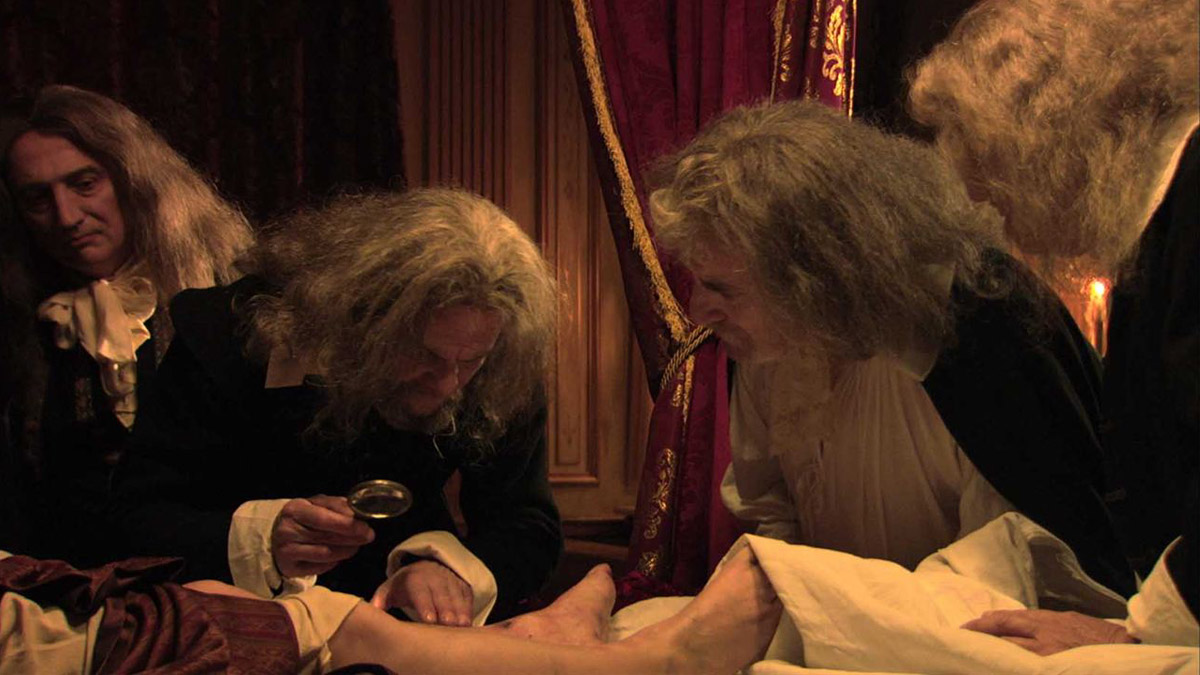A Question of How
Albert Serra’s characters need no introduction and it’s just as well, for there’s no pinning down such vast figures as Quijote, Dracula, or the Three Wise Men anyway. Serra simply presupposes knowledge of their stories and their prior manifestations, freeing him up to focus on the matter at hand: to explore what it might feel like to be in their company, encounter them face to face, watch them move through space, see their reputations give off sparks. His are stories of experience and sensation, histories of the body and gentle, arch revisionism. The title of La mort de Louis XIV already takes the strategy of prior assumption one step further: we aren’t just acquainted with our protagonist, we also know what will happen to him. Like in all of Serra’s films, it’s not a question of what, but rather of how.
In the film’s first shot, it’s still just about bright enough for the garden flowers to glisten, although the evening mist is already beginning to envelop the landscape. The last rays are gone by the time the king appears in the next shot and they don’t return, this won’t be a film about blazing sunshine, but rather the stubborn residue it leaves behind. The monarch takes to his bed and never properly leaves it again, the kingdom beyond his chambers just a blur through paneled glass, a secondhand report of collective joy. The candlelight and the tight framings often make it hard to tell night from day and the gap between each cut could be an hour, a second, or a month. Different ways of marking time now come to the fore: the tautness and texture of flesh, the length of the pause before the response, the progress of a stubborn black stain up and over a leg.

On one level, nothing has changed, the king remains at the center of things, his courtiers and servants still circle around him, his every whim catered for, his every modest gesture cheered. Yet as the sun fades and its pull weakens, it becomes clear that this meticulously constructed solar system was never built for change and all it knows is to keep on spinning. Watching the system revolve around an increasingly empty centre only throws its ridiculousness into sharper relief: a fawning story tips over into the excruciating when it no longer elicits the expected response, the intricacies of coastal defenses become wryly amusing when repeatedly ignored, and a nocturnal coughing fit can still only be brought under control by water from a crystal glass. The court’s inner circle can only vacillate between two strategies to deal with a decline we already know is unstoppable, both of which ultimately amount to the same thing. Whether clutching at straws to try and save the king or pretending he doesn’t need saving at all, there’s nothing more important than preserving the status quo, inconsistency or charlatanism be damned. Even when the end is nigh, his word is still everything, just as it always has been: he will decide whether to go to the chapel, he will decide when the rites are to be read, it was his decision to make sure that nothing could function without him.
But for all the activity at the margins, the eye is still always drawn to the center, to the silent spectacle of a star throwing off its outer shell. Drained of luster, a body is just a collection of parts: eyes that already look like glass, a heart to be extracted in line with tradition, a stretch of disgustingly bloated intestine. As the skin around the eyes contracts, the hand shakes as it leads the spoon to the mouth, and the lips constantly fidget, the movements feel so real you ask yourself what’s behind them: Serra’s conception of the king, Jean-Pierre Léaud’s interpretation, or simply the involuntary spasms of an aging anatomy. It’s a fascination born of uncertainty, the uncertainty of not knowing where one body stops and another begins. When the music swells on the soundtrack for the first and only time and the prone sovereign finally returns the camera’s gaze, it’s impossible not to think of someone else looking at the camera in a different place, at a different time, a small boy on a beach with defiance in his eyes, not resignation, an entire reign as the space between two matching expressions.
The king’s gaze is fleeting however, unlike the portrait hanging on the wall of the royal bedchamber that sporadically comes into view through the varying degrees of darkness. Its own mournful gaze always seems to be directed at the monarch, one congealed counterpart to all the living ones that structure the film, perhaps the defining feature of royalty is that no one can take their eyes off you. Serra has such an unfailing grasp of composition that you could freeze any one of his unobtrusively precise arrangements of light, shadow, furnishings, and faces and you’d have another painting, each of which an irrefutable assurance that at that moment at least, the king was still alive. There’d be room enough in the palace to hang each and every one of them and circling through its halls would be akin to watching a film, the only difference being what provides the movement. In both cases, it’s the play of light across faces that would tell you where you are in the story. It’s the light from within that dims first, and as the flesh sags and turns waxy, it loses the ability to reflect: deprived of light, the features then disappear one by one. Death is thus a flat surface, death is a blank canvas, but death is also not the end, for in this palace, you can always go round again. As the doctor says, let’s just do it better next time.


